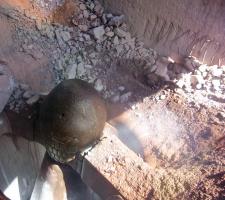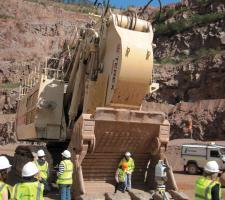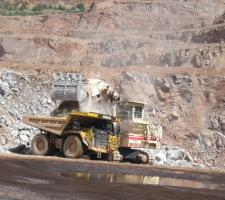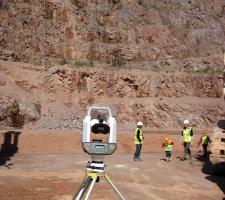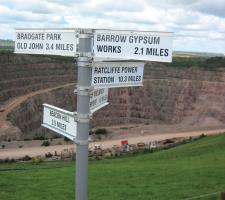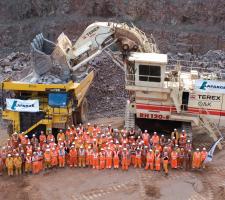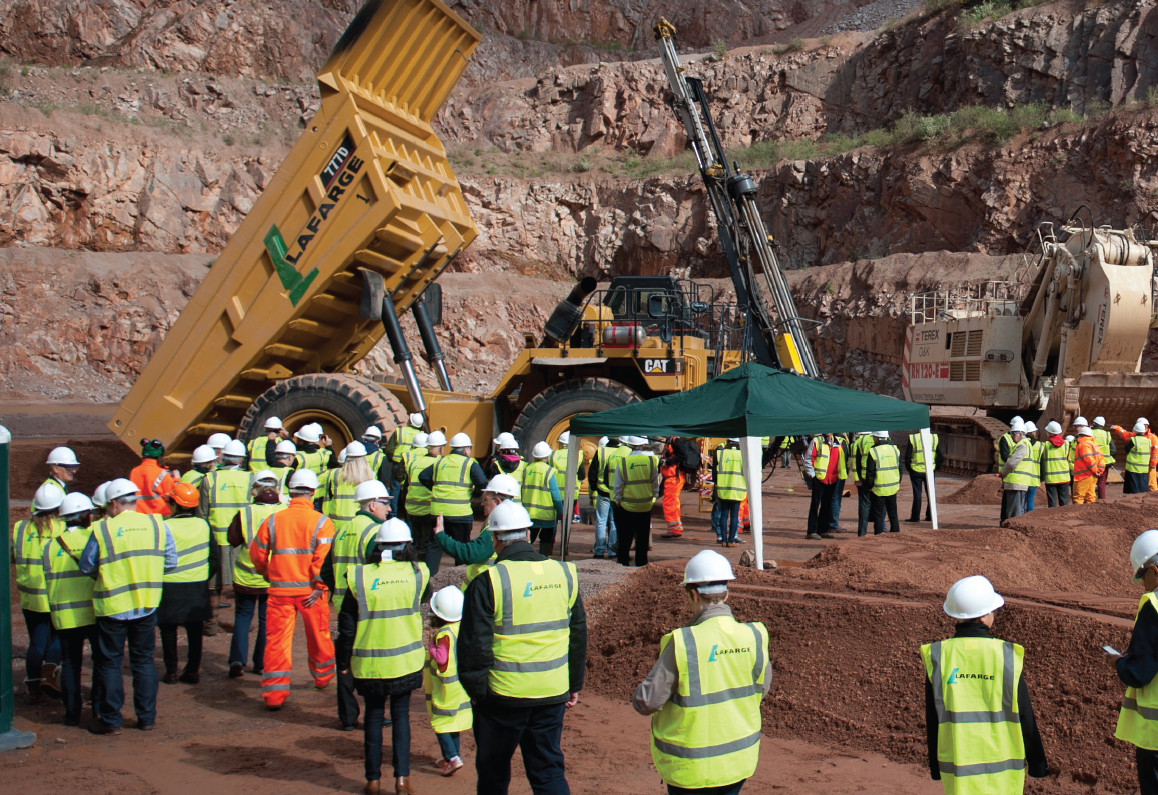
One of the biggest granite quarries in Europe is seeking to make the best use of available reserves. Patrick Smith visits Mountsorrel
Overlooking the area around the small rural villages of Mountsorrel and Quorn is a newly-carved statue of a local worker called ‘Albert’.
It stands near a footpath at a restored quarry in the County Leicestershire, central England villages, and has been erected as a memorial to past, present and future quarry workers, and a tribute to the site’s community heritage.
Little is known about ‘Albert’, except that he was a sett-maker in the area around 100 years ago, and the carving, carried out by Graeme Mitcheson from Castle Donnington, also in Leicestershire, was inspired by an old photograph showing a man, nicknamed ‘Albert’, shaping cobblestones for road building.
Mitcheson used granite, a rock that is available in abundance at Mountsorrel Quarry, home to Lafarge Aggregates & Concrete UK’s flagship quarry, which is said to be one of the largest granite production quarry sites in Europe.
That said, everything about the Mountsorrel Quarry is big, from the 200m deep hole that has been formed since quarrying started at the main site nearly 40 years ago, to the 2,400tonnes/hour primary crusher.
And to ensure workable granite reserves are not lost and supplies are maintained, Lafarge is hoping to seek planning permission to extend the quarry towards the end of 2013, with plans to locate a proposed new primary crusher and the primary surge pile in the quarry void.
The plans were presented for the first time at a series of open days at the quarry in May when some 43,000 plus visitors from across Charnwood district visited to discover how a modern quarry works, and to learn about Mountsorrel’s rich heritage and hear about the plans.
If planning permission is granted at the 80 hectare site, which currently employs 140 people, many from within a 16km radius, more granite will be quarried over the coming decades.
Current production is between 4-4.5 million tonnes a year, 1 million tonnes of which is supplied as track ballast to
A very carefully designed mine plan is used to work out where and when the company will quarry the granite, much of which goes to the heavily populated south-east of England, a region that does not contain any hard rock minerals, but where there is always a large demand for such products, which are used for housing, schools, hospitals, roads and rail links.
“These open days are the biggest public events ever held at Mountsorrel,” says quarry manager Angus Shedden.
“The tours into the quarry were a real hit, and people have been amazed at the grandeur of the quarry itself and fascinated by the processes which turn lumps of rock into essential construction materials.
“People have also been truly surprised by the depth and richness of quarry site’s heritage and how it has played a significant role within Charnwood for more than two centuries.
“Apart from our history we also wanted to show people what we want to do going forward. We have planning until 2033 and although there are around 95 million tonnes of permitted granite reserves at Mountsorrel only about 25 million tonnes are readily available to work before new production options must be found.
“We want to move the primary crusher and surge pile three or four benches down on the north-east side of the quarry and by doing this it will reduce further noise, dust and vibration for the community. It also means we will not have to haul the rock as far up to get it to the crusher.”
The Granodiorite rock at Mountsorrel, part of a large igneous intrusion which forced magma up into the earth’s crust around 450 million years ago, is made from crystals, and it is the high proportion of large pink crystals that give Mountsorrel granite its characteristic pink colour.
Indeed, being so hard wearing the granite is very abrasive and the steel on the excavator buckets wears out so quickly that two welders are on hand replacing the steel on the buckets every night.
To gain access to the granite some 10 million tonnes of clay has been removed over 30 years. The clay, used to construct screening mounds, consists of a Keuper Marl mudstone deposited 250 million years ago, a time when dinosaurs roamed the earth.
At present the quarry has 12 benches varying in depth from 15m-18m, but as it goes deeper it narrows and this is one of the reasons why Lafarge is looking at options to widen the quarry rim.
“We have a deep hole which is 100m below sea level and all the rock is hauled out using nine dump trucks including four [
Each excavator weighs 286tonnes, has two 500kw diesel engines and costs £2.5 million (€3 million) to buy. While the primary crusher can crush granite up to 1m in size, any rocks bigger than this require breaking and the excavator has a 6tonne manganese steel ball which it drops onto the larger rocks to reduce their size.
The 90tonne dump trucks, each of which is expected to complete 30 loads per day to produce the 20,000tonnes, means the roads have to be kept in good condition and this is achieved using a grader.
This important operation saves operators driving over pot holes and to prevents spillage from the dump trucks as a rock near the excavator or on the haul road can easily damage tyres, which cost around £10,000 each.
In recent years Lafarge has significantly improved access onto the machines by fitting excavators and dump trucks with access stairs as a safety standard, and all the operators go through rigorous training and assessments on the machines to ensure they are competent.
The dump trucks bodies are rubber-lined steel bodies to help resist abrasion, meaning the operating life of each is increased by three to five times. The lining also absorbs the shock of the granite as it is loaded into the dump truck improving operator comfort.
Even so it takes a fully loaded dump truck 20 minutes to drive along the haul road to the crusher two miles (3.2km) away.
The edges of the haul road are built up with 2m high bunds of rock and quarry fines to prevent vehicles falling over the edge, and reflective safety signs show drivers the edge position.
“We blast five days a week at 12.30pm and we have our own drill rigs onsite: everything is done in-house by our own operators. We use
Before every blast holes are drilled 19m into the granite, 4m apart, with around 30 holes being drilled for every blast.
“After drilling we bring in our specialist blasting team who use high-tech surveying equipment to carry out a very detailed survey of the quarry face,” says Shedden, who pointed out that a blast detonated by a local resident following an open day competition raised £250 (over €300) for the Prince’s Trust, one of a number of national and community organisations which Lafarge supports.
The survey is used to calculate the optimum amount of explosives to put in each hole to ensure the granite is fractured safely; to minimise vibration and to enable the machinery to access the granite easily and safely.
The holes are loaded with explosives delivered early in the morning in a safe condition and only become active when the shotfiring team load them into the holes ready to fire.
Each blast is monitored by four vibration monitors located around the quarry boundary, and a mobile vibration monitor is sent to the closest residential street.
The results from the monitors are downloaded and shared with Leicestershire County Council each month to ensure continued responsible operations.
Likewise, noise and dust are monitored around the site boundary by external environmental specialists, and the results, reviewed by the quarry, Charnwood Borough Council and Leicestershire County Council, are said to have demonstrated that the environmental improvement works carried out on-site have been effective.
“Everything is brought up by the dump trucks to the gyratory primary crusher, a Nordberg 6104, which has been on site since we started operations at this quarry, although obviously wear parts have been replaced. It was the biggest in the world when installed and remains one of the largest crushers in any aggregates quarry. The idea was to produce big volumes of material.”
The crusher, made out of manganese steel that has to be replaced every two years, can be loaded from both sides by dump trucks to even out wear and offer a quicker cycle time and is capable of processing the 90 tonnes of rock from each truck in just 90 seconds.
After being processed by the primary crusher material is screened and the fine material that drops through is taken off for sale.
“After crushing, the remaining larger material continues up the conveyor onto the main surge pile, which has a 140,000tonne capacity. This allows the quarry to operate when the main processing plant is being repaired. That marks the end of what we call Phase One,” says Shedden.
Any water that gathers in the bottom of the quarry is pumped out of the quarry hole and into the old Hawcliffe Quarry (one of the original quarries on site), which is used as the main water storage lagoon in what is claimed to be one of the world’s biggest rainwater harvesting schemes. The water is used for dust suppression and washing of aggregates, and makes the site almost self-sufficient in water.
Quarrying in and around Mountsorrel started in earnest in the second half of the 18th century to meet the increasing demand for building materials thanks to a boom in construction and road building although there is evidence quarrying has taken place in Mountsorrel since Roman times around 2,000 years ago.
Real commercial progress began in 1854 when the local Martin family established the Mountsorrel Granite Company (MGC) operating four sites at Mountsorrel: the main Broad Hill Quarry plus smaller sites at Hawcliffe, Nunckley Hill and Cocklow Wood.
An Act of Parliament in 1858 to build an extension to the Midland Counties Railway saw Broad Hill Quarry become the first industrial operation to have its own branch [railway] line and sidings at Barrow-upon-Soar while in 1860 England’s longest spanned brick-built bridge was constructed to take the line over the River Soar.
Lafarge still uses the sidings of the Victorian-built railway as the hub supplying its rail network but the railway line has been replaced by a 3.2km conveyor system that carries products in just 12 minutes from the quarry for distribution.
Lafarge operates a dozen railheads and asphalt plants in south-east England, and these are supplied by rail from the Barrow sidings while it also has a self-discharging train which allows granite to be offloaded anywhere on the rail network.
Indeed, some 60% of everything produced at Mountsorrel is distributed by train and loading can be carried out 24-hours-a-day. With over 30 trains leaving the railhead every week, this is equal to around 2,200 trucks not having to deliver by road. In 1959 Redland took over the Mountsorrel Granite Company heralding a new era of mechanisation and investment and in 1967 operations stopped at Broad Hill and concentrated instead on Cocklow Wood.
Infilling of the 50m deep Broad Hill Quarry was carried out from 1969-1994 and it is now restored to its profile of the mid-1850s. Within the last few months a footpath over Broad Hill has been opened, providing great views of the Soar valley.
All restoration work at the site is managed under schemes agreed with the local planning authorities,
In 1974 quarrying started at Buddon Wood, where Lafarge manages the Site of
Redland, which now owned other quarry sites as well as concrete and asphalt plants, was taken over by Lafarge in 1997.
“Today our main processing plant which is known within the site as Phase Two has nine gyratory crushers and while the process is quite complex we can keep making the aggregates smaller as required,” says Shedden.
Equipment in this phase includes two 7ft Standard crushers; one
“We are primarily looking for railway ballast which is 40-63mm in size. Then we mix and match as required to different sizes depending on the amount people want.
“Within the phase two processing plant we have invested some £4 million (€5 million) on 18 new 12m long, 3m wide screens. This investment is the same amount that was used to build the whole plant in 1973. We started processing in 1974,” says Shedden.
Excavators
2 x Terex (O&K) RH 120-E
Dump Trucks
1 x Caterpillar 777C
4 x Caterpillar 777D
1 x Caterpillar 777F
2 x Komatsu 785
1 x Terex TR100
4 x Caterpillar
Crushing
1 x Nordberg 6104 (primary)
2 x 7ft Standard
1 x Sandvik C870
1 x Metso HP5
1 x 7¼ Nordberg
3 x 4¼ Nordberg
1 Omnicone
This is only half of the screens on-site and the other half will be replaced later this year.
From Phase Two everything is sent to covered storage buildings known as the toast rack [because of its resemblance] and each of its 12 storage bays can hold 3,000tonnes of material.
This is Phase Three, and underneath each bay are four conveyors allowing sizes to be blended together into many different products.
The conveyors also supply two asphalt plants (Standard Havens drum mix and KVM batch plant) that produce up to 600tonnes/hour of asphalt products for road construction; a 2,000tonnes/hour system feeding the railhead at Barrow on Soar; a 2,000tonnes/hour washing plant that can feed road trucks or the railhead, and four automated truck loading bays for drystone products.
With product quality of primary importance an on-site laboratory tests products to ensure they meet the highest standards.
“We also have on-site an asphalt and glass recycling area, and although most of our material goes by railway we have a dedicated road, Granite Way, that goes into the A6 and then links to the rest of the network and London,” says Tim Deal, Lafarge Aggregates & Concrete UK’s national mineral development manager, based at the Syston, Leicestershire, headquarters where 450 people are employed.
Shedden added that in addition to the wages of its staff, a further £10 million (€12.5 million is) spent by the quarry every year on contractors and suppliers, many of whom are local, and it contributes over £750,000 (€937,000) to Charnwood Borough Council in rates.
Independent estimates suggest in the period up to 2033 the quarry will bring an extra £126 million (€157.5 million)to the regional economy.
Lafarge’s preferred option
A number of options are on the table to make sure the local and national supply of granite is safeguarded for the next 20 years from when the new crusher comes into operation
Lafarge’s preferred option would release 60 million tonnes of rock reserves and would require the removal of some 5 million m³ of overburden.
Four main areas for overburden disposal have been identified including the quarry itself and 40.4 hectares of new land for the construction of fresh landforms.
“In order to create a platform needed to relocate the crusher and the primary surge pile, it is necessary to include some peripheral parts of the Buddon Wood SSSI,” says Lafarge.
“However, the scheme will include significant measures to protect the area’s important wildlife and ecology during operations and will also provide for long-term management.”


